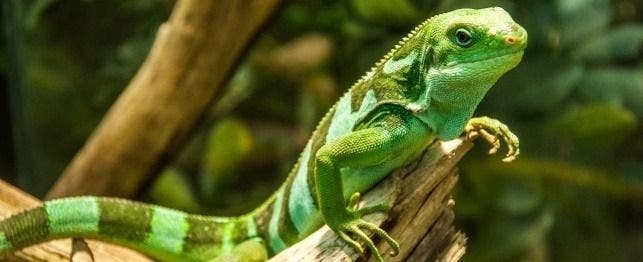
Choosing a Lizard
Lizards are the most diverse group of reptiles. More than 3,800 species have been identified, and they live on all continents except Antarctica, in habitats as varied as deserts, oceans, grasslands, forests, and cities. They range in size from the monito gecko, which matures at slightly over an inch, to the komodo dragon, which can reach more than 10 feet in length. Lizards first appeared in the Triassic Period (245 to 200 million years ago) and later gave rise to the snakes.
Appearance
Like all reptiles, lizards have scales and are dry to the touch. They are ectotherms, which means that their body temperature depends upon the temperature of the environment around them. In the wild they regulate their body temperature by finding shade or heat. To enhance the absorption of heat, many darken their skin by releasing the pigment melanin. In captivity, they must be provided with a range of temperatures. Because they live in such diverse habitats, lizard species have evolved a wide array of locomotive abilities. Desert dwellers “swim” across sand on fringed toes. Glass lizards that live in the riverbank forests of the American southeast have dispensed with legs altogether and move like snakes. The basilisk can run across a pond’s surface on its hind legs. Flying lizards can glide from trees, assisted by wide flaps of skin. Many can swim and the marine iguana enters the ocean to feed. Many are fast runners (some, such as the leopard lizard run on two feet) and green iguanas will plunge from trees into rivers.
Breeding
Most lizards reproduce by laying eggs, but many give birth to live young. As with many reptiles, the sex of the young is determined by temperature at which the eggs are incubated. Parthenogenesis (reproduction without mating) has been developed by a number of species.
Vision is a lizard’s most important sense (although some fossorial lizards, those that burrow, such as blind lizards, are nearly sightless). While most lizards have movable eyelids, those of many geckos are sealed and clear like the eyelids of snakes. Only the chameleons can move each eye independently. Hearing is well developed in vocal species such as the Bornean earless monitor. For smell, many lizards rely on a series of pits in the roof of the mouth that connect to the brain and analyze scent particles gathered by the tongue. This is called the Jacobson’s organ. Many species have a “third” or parietal eye, a skin-covered opening in the top of the skull that senses light cycles, and thus controls breeding and basking periods.
Communication among lizards is complex and extraordinary to observe. They may bob their heads, do pushups, wave their tails or flare their dewlaps or headcrests. Some species such as desert iguanas mark territories with their scent while others such as barking geckos vocalize. Despite the popular notion that color changes (most highly developed among the chameleons) are used as camouflage to mimic the lizard’s surroundings, they are instead used for marking territories, attracting mates and forestalling suitors.
Food
Most lizards feed on insects and rodents. This simple diet makes them easy to keep so long as attention is paid to supplementing these foods as necessary.
Consider the space you have for your lizard before you decide which one to buy. They grow quickly and need a great deal of room to move around. Many have bought lizards such as iguanas when they’re small and then found they had no room for them when they became adults.